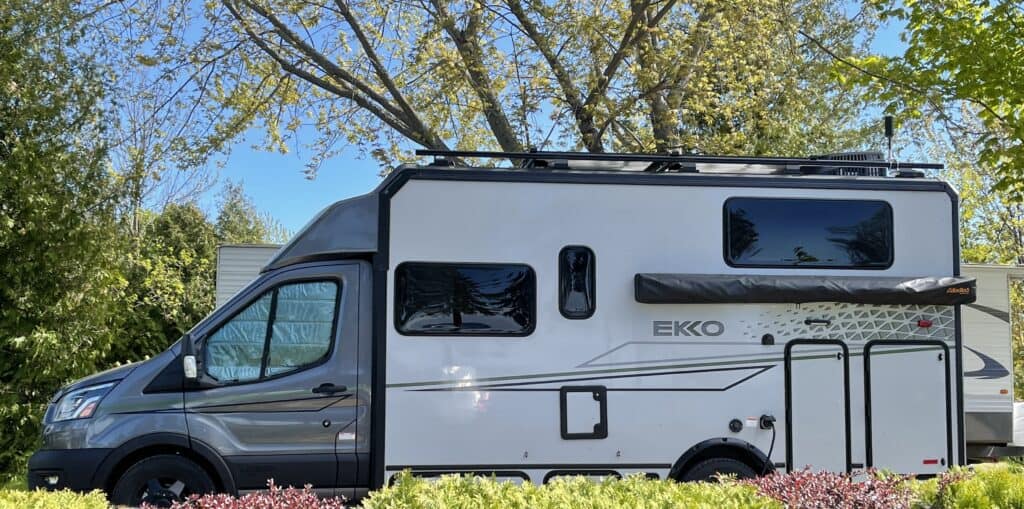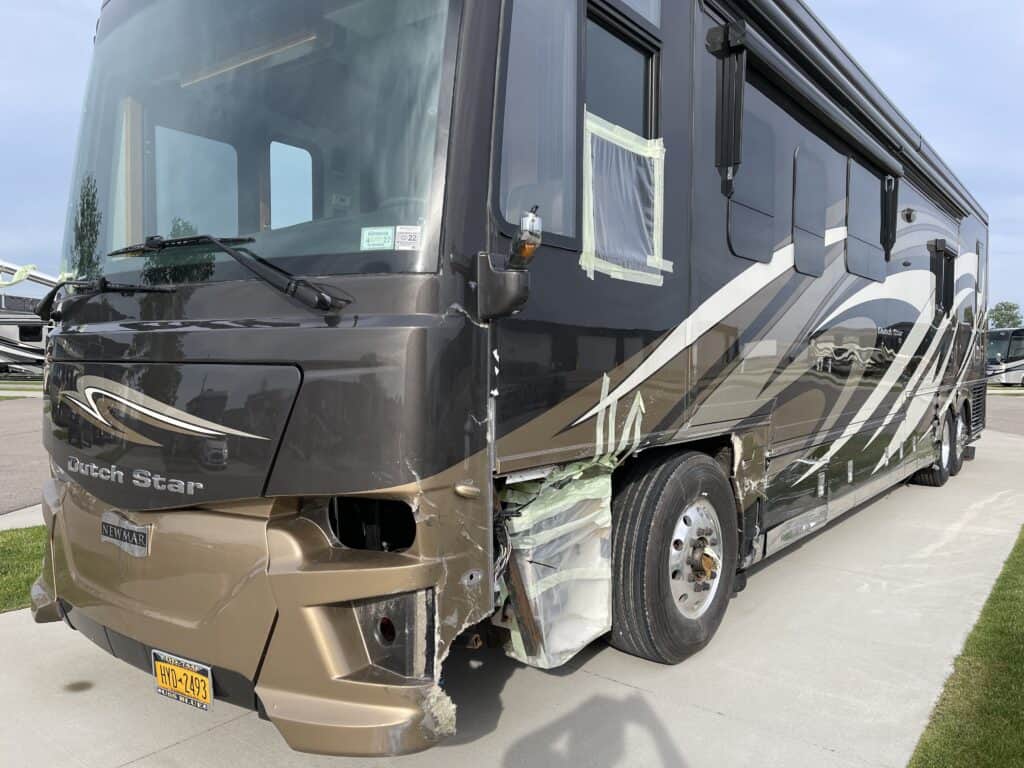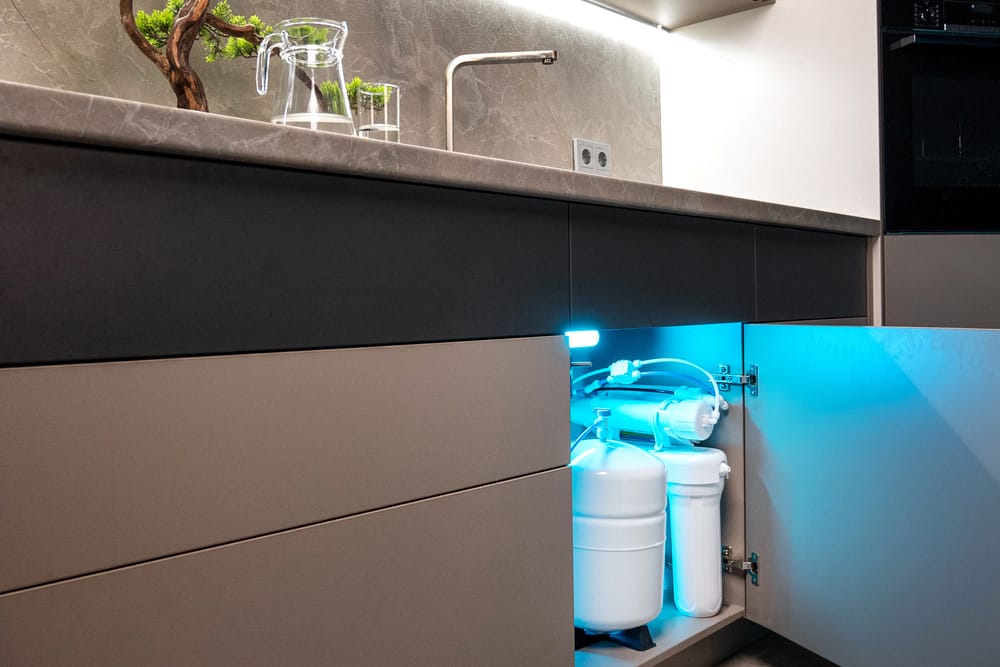
Don’t Buy The RV If You Spot These Red Flags
Whether you’re buying a new or used RV, there are many red flags to be aware of. Just because the RV came straight from the manufacturer to the dealer where you are shopping doesn’t guarantee it’s free from costly defects. We met a family at Mt. Hood Campground and Resort in Oregon whose brand new fifth wheel caught on fire (due to a defective furnace) before they had owned it for a week.
Fortunately, the whole family got out safely, and they were able to limit how much of the trailer burned before the fire was extinguished. However, they received nothing but a frustrating runaround from the dealer who sold it to them and the manufacturer which built the trailer in the first place.
Neither one wanted to take any responsibility for the fire, the damage, or the inconvenience it caused this full-time RV family. They struggled for months to have the problem rectified.
Where are you shopping for an RV?
Obviously, the market today is much broader than it was a couple of decades ago. Today, RV shoppers are not limited to the available inventory in their immediate area. With the internet and online databases, like National Vehicle and RV Trader, shoppers can view available new and used inventory from anywhere in the country.
As an example of this contrast, we bought our first motorhome in 1999, new, from a dealer. At that time, our choices were limited to the inventory on the dealer or consignment lots within driving distance of our home. Twenty years later, in 2019, we bought our second new motorhome from a dealer. However, this time the dealer was literally clear across the continent.
We were on the West Coast, and the RV was in Florida. Now, I’m not recommending that anyone buy an RV that they haven’t personally inspected. That could lead to huge disappointments! But with the internet, you can easily shop anywhere, compare features, floor plans, costs, etc. In our case, we left the door open to cancel the deal if the RV didn’t precisely match the description. However, we had driven over 2000 miles to get it, and we were highly motivated to complete the purchase, which could have colored our judgment if we had discovered deficiencies (fortunately, we did not).
Get an inspection
My recommendation, however, is to personally inspect any RV (new or used) that you are considering buying. If possible, use a third-party inspection service to verify its condition (this may not be possible at a dealership, especially with a new RV), but an independent inspection of a used RV would still be a good idea, even at a dealership.
The dealer might give you a little grief, saying that they had already run the RV through their own internal inspection process, so a third-party inspection is not necessary. But had they really checked everything that would be important to you? And if they have inspected it, will they make their inspection report available to you? Finally, when shopping for either a new or used RV, I recommend that you be on the lookout for any of the following red flags listed in this article that may manifest themselves during your personal inspection process.
Don’t rely on warranty repairs
When buying a new RV, be sure to check its “fit and finish.” These are the little things that may not be quite right, like a cabinet door that doesn’t close tightly, a sagging roof liner in a basement compartment, an electrical plug with no power, a loose attachment of the steps, a window that won’t open, a scratch in the exterior paint, and so on. The dealer may tell you that these are all warranty issues that are covered by the manufacturer. And many RV dealers are happy to let you drive the new RV off their lot, and from that point on, it’ll be your responsibility to arrange for warranty repairs.
Your dealer may not be capable of doing the warranty work. For example, some service departments aren’t equipped to work on motorhome chassis problems (transmission, engine, brakes, starter, etc.), nor will they service an onboard generator or fix a problem with the furniture’s upholstery, nor can they even replace the tires. It’s frustrating (and in my opinion, alarming) that they’re willing to sell you a new RV with known problems but don’t disclose that they won’t be able to fix those issues.

Finding dealer support can be difficult
In the case where the dealer won’t or can’t fix the problem, you may need to take your RV to a variety of providers to get all the problems corrected. The time, effort, and frustration of buying a new RV and then experiencing the stall and runaround tactics from the manufacturer is disappointing at best and immensely frustrating at worst.
Some manufacturers even expect you to bring the RV back to the factory for warranty work. If you live close to the Tiffin factory in Red Bay, Alabama, or the Newmar factory in Nappanee, Indiana, or just down the road from the factory that built your particular RV, that may be a reasonable request. But if you’re a couple of thousand miles away and can’t afford to take a month off to travel back and forth to the factory, it’s completely unreasonable and an unworkable solution to getting warranty work completed on the new RV you just purchased.
Example
The family whose fifth wheel caught on fire is one example. Another couple we met bought a new RV, but the main entry door did not close properly, so there was a visible ½” gap between the door and the door frame. The dealer assured them it was a warranty problem that could be quickly resolved. After taking possession of the trailer, they learned that the dealer was not equipped to fix the problem. When the buyer contacted the manufacturer, their claim was repeatedly denied.
As it turned out, the entire door and door frame needed to be replaced. The dealer washed their hands of it, and the manufacturer was clearly using a stall technique, hoping to postpone the repair until the trailer was beyond the warranty period. We have heard many stories like this from RVers and independent service techs, and it highlights the need to do your due diligence when buying a new RV. You need to investigate the brand’s reputation. Not all RV manufacturers are like this, but some are, and this should be the very first red flag if you are buying a new RV.
Check online forums like iRV2 for the specific brand you are interested in buying and learn all you can about the manufacturer’s reputation. Ask the dealer what warranty work they will and will not perform and check the online reviews for the dealership as well as the manufacturer. If possible, don’t take possession of an RV before the dealer corrects all the known fit and finish issues. Let them deal with the manufacturer for the covered work.
Buying a used RV
Now, if you’re one of the many RVers who would never even consider buying a new RV, you don’t need to worry about fit and finish issues and how to get the manufacturer to pay for covered warranty work, but you’re certainly not off the hook. There are so many components in an RV that could become costly repairs if defects are overlooked. It will be up to you to confirm that the RV you’re hoping to purchase isn’t riddled with these problems, unless you’re looking for a DIY fixer-upper. Therefore, you need to take your time and personally inspect any used RV before you commit to buying it.
During the inspection, don’t let the seller distract you. Use all your senses to spot red flags. Look for defects; listen for dripping water or joints that creak; be aware of the smells of the RV; and feel the surfaces for bowing, delamination, bubbling, or moisture.
Be analytic and ask questions. Obtain the VIN (Vehicle Identification Number) and check it to make sure the vehicle listed on the title is the same RV you’re inspecting. Don’t just use CarFax as the only source of information about the RV because some negative history might not have been reported to CarFax. You can ask your local DMV to check the history or use a free online VIN Report service.
Take your time! If the RV can be driven, then take it on a test drive. If it’s a towable RV, then check the hitch and light harness to make sure they’re both working properly. Keep these red flags in mind when you’re doing a comprehensive inspection of an RV.

Red flags that a problem might exist
During your RV inspection, watch out for these red flags that may indicate issues. Keep all of these in mind as you work your way through the RV and talk to the seller.
- The RV owner or dealer is opposed to a professional inspection.
- The RV is winterized so no water tests are possible.
- The seller won’t or can’t make shore power available.
- The seller can’t demonstrate the function of the jacks or slides.
- The owner doesn’t have a clear title.
- The VIN number does not match the RV description.
- The VIN records show the RV has been wrecked or rebuilt.
- The owner is ambiguous when discussing the RV.
- A dealer who claims they don’t know the history of the RV.
- Or a dealer who knows too much history. Are they making it up?
- There’s an unexplained mismatch between the miles and the age.
- The seller is much too eager to sell.
- The seller is evasive.
- The deal is just too good to be true (this probably means it really is).
- Finally, you sense the deal is a scam.
Inspect ALL these RV components
Even if you don’t spot any red flags right away, it is critical to inspect all of these components before purchasing the RV.
Electrical
Ask the seller to connect the RV to shore power so you can test all the electrical components. Plug a light into every outlet to make sure power is available. Turn on every light to make sure they are all working correctly. Test the TVs, air conditioners, water heater, and every electrical appliance.
Water
Run the hot and cold water in every fixture. Listen for dripping water and look under the faucets for current leaks or past damage from leaking pipes. Check the floor around the shower for sponginess, which would indicate dry rot in the subfloor.
Check for mold
An older RV that has been closed may smell musty. However, if it’s mold you smell and not a musty odor, you’ll need to identify where the mold is and if it can be eliminated.
Mold may be visible on the surface of the wall, ceiling, or floor, but the bulk of the mold might be just below the visible surface indicating a much larger problem.
Check the floor, walls, and roof for signs of water damage.
Jacks and slides
Have the current owner or dealer demonstrate the correct operation of the jacks and slides. Then try to extend and retract these vital components several times to be sure they are moving correctly. Have someone else operate the slides and jacks while you watch from the outside to see if they move with fluidity.
Roof
Go on the roof (if it’s the kind of RV that allows roof access), or get a ladder so you can see the roof from the ladder and inspect the roof joints and caulking. Inspect the roof vents, air conditioning units, air conditioner shrouds, antennae, and solar panels (if present).
Exterior walls
Walk all the way around the RV and inspect the walls. Look for delamination, rippling, bubbling, collision damage, or other evidence of defects. Look for damage to the paint or other issues that could lead to costly repairs.
Tires
Inspect the tire condition and age. All tires are marked with a four-digit number. The tire’s manufacturing date is indicated by the first two digits for the month and the next two for the year. Good tread does not guarantee a tire’s condition, so even if it appears fine but is old, it should be replaced.
Closed spaces
Open every cabinet, drawer, basement, engine compartment (if it has one), or any enclosed space. Look for signs of vermin droppings, insect infestations, mold, or water damage.
RVs are a breeding ground for pests like mice, ants, spiders, stink bugs, moths, wasps, and other insects. Infestations are unsanitary, hazardous, and may signal wiring issues. Eliminating these pests without harmful pesticides is challenging.
Galley function
Check all the appliances to make sure they are operational. Do the refrigerator and freezer work correctly? Are there offensive odors in the refrigerator? Do all the burners on the stovetop work when the propane is turned on? Make sure there’s no smell of gas indicating a leak in the gas line. Test the microwave and convection oven if it’s so equipped.
Batteries and generator
Test the starting function of the generator (if the RV has a generator). Also, be sure that it is correctly connected to the vital electrical systems so that when the generator is running, there’s power available in the microwave, outlets, and TVs. Also, check the power level in the house and chassis batteries.
Owner-installed systems
Ask the current owner what add-ons or modifications they have made to the RV. Did they change the acid-lead batteries to a lithium battery system, or put solar panels on the roof? Did they install an RV water filtration system? Did they have the work done (and if so, by whom) or did they do the work themselves? Inspect the work, get a detailed description of what work was done, by whom, and for what purpose.
Get a third party inspection
After inspecting the RV, arrange an independent third-party inspection to catch any missed issues. It may cost a few hundred dollars but it will be worth it. A professional inspection ensures a fully operational purchase and peace of mind.
Conclusion
Scammers are experts at disarming their “mark,” so if you have a gut feeling that something doesn’t seem right, don’t ignore it! This caution is particularly applicable when buying in the peer-to-peer market, but dealers may also be scammers.
One way to avoid scammers in the private marketplace and to safely transact your business is to buy an RV that has been listed by a reputable firm like National Vehicle. They start their process by doing a free professional valuation of every RV, which they list on their For-Sale-By-Owner website.
They’ve done some of the legwork to confirm the VIN and description, ensuring it’s not a rebuilt RV. They also advised the owner on the RV’s current value, so you know it’s priced fairly. Private sellers with National Vehicle usually price their RVs higher than wholesale but lower than retail, saving costs for both parties.
However, it is always important to keep an eye out for red flags, no matter where you are shopping for an RV, to ensure that your new rig will be both comfortable and functional. For more tips on buying an RV, browse online forums like iRV2.com and brand-specific websites like Air Forums, Forest River Forums, and Jayco Owners Forum.





Regarding tires, the DOT tire date is the week and year.
The first two numbers identify the week and the last two numbers identify the year of manufacture.
Example ‘DOT3921’ = the 39th week of 2021.